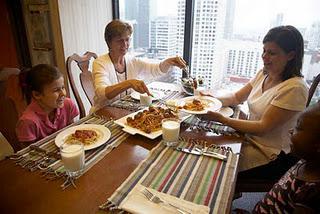
Family mealtimes really matter – to children and to adults. Mealtimes matter both for the nutrition from MyPlate on the Dinner Table and for the conversations family and friends have around the table.
More positive mealtime conversations can help family communication, language skills, and even performance at school. Here are five easy ways to enhance the quality of conversations at any meal.
Create a relaxed atmosphere.
Quality conversations require a calming atmosphere – with minimal distractions. This means turning off the TV and radio news programs; it also means setting aside cell phones (except for emergency calls, of course). Music can be a nice addition – if it is tranquil, peaceful, and played at low volume.
Focus on laughter and learning.
Meals are generally not productive times to discuss difficult or stressful issues. They are wonderful times to share funny stories and to learn new views on current events. Make a family commitment to focus only on the positive at the mealtimes. Save disciplinary matters and problems for another time of day.
Respect and involve every family member.
Even very small children want to be part of the conversation. Make a conscious effort to engage everyone at the table. Be patient with those who take longer to express a thought – and actively seek out the opinions of those who tend to be quieter. Sometimes it helps to go around the table person-by-person.
Use conversation starters.
Tired of conversations that fall silent after a minute or two? Conversation starter cards may be just what your family needs to keep things lively at the table. Eat Right Montana Conversation Starters can be downloaded from the website (scroll down to April 2007).
Enjoy different viewpoints.
Promoting positive conversations doesn’t mean that everyone has to agree on everything. Establish a few ground rules – like no teasing, criticizing, rude comments about other people, or talking while someone else is talking. Listen thoughtfully to each other – and help children learn to appreciate differences.

